Abstract
The effect of natural killer (NK) cell alloreactivity on the outcome of unrelated hematopoietic SCT (HSCT) remains a topic of debate. NK cell alloreactivity after allogeneic HSCT is regulated by killer-cell Ig-like receptors (KIRs). To investigate the influence of KIRs on outcome after unrelated HSCT, we retrospectively analyzed the HLA and KIR genotypes of 116 donor–recipient pairs. We found that missing KIR ligands in recipients were significantly associated with a decreased leukemic relapse risk (P=0.019, HR=0.329), mainly in myeloid disease (P=0.003, HR=0.193). This beneficial effect was seen in AML/myelodysplastic syndrome and also in chronic myeloid leukemia. In myeloid disease, missing KIR ligands also improved 5-year OS (P=0.034, HR=0.430) and disease-free survival (DFS) (P=0.024, HR=0.445). Meanwhile, the presence of donor-activating KIR2DS3 gene was associated with increased relapse risk (P=0.003, HR=5.046), decreased OS (P=0.004, HR=3.181) and DFS (P=0.003, HR=2.919) in myeloid disease. No effect was seen in patients with lymphoid disease. Our study indicated that, in unrelated HSCT for myeloid leukemia, missing KIR ligands in recipients offered a lower relapse risk and a long-term survival advantage. The presence of KIR2DS3 in the donor was an important risk factor for myeloid leukemia.
This is a preview of subscription content, access via your institution
Access options
Subscribe to this journal
Receive 12 print issues and online access
$259.00 per year
only $21.58 per issue
Buy this article
- Purchase on Springer Link
- Instant access to full article PDF
Prices may be subject to local taxes which are calculated during checkout



Similar content being viewed by others
References
Flores-Villanueva PO, Yunis EJ, Delgado JC, Vittinghoff E, Buchbinder S, Leung JY et al. Control of HIV-1 viremia and protection from AIDS are associated with HLA-Bw4 homozygosity. Proc Natl Acad Sci USA 2001; 98: 5140–5145.
Ruggeri L, Capanni M, Urbani E, Perruccio K, Shlomchik WD, Tosti A et al. Effectiveness of donor natural killer cell alloreactivity in mismatched hematopoietic transplants. Science 2002; 295: 2097–2100.
Robertson MJ, Ritz J . Biology and clinical relevance of human natural killer cells. Blood 1990; 76: 2421–2438.
Smyth MJ, Hayakawa Y, Takeda K, Yagita H . New aspects of natural-killer-cell surveillance and therapy of cancer. Nat Rev Cancer 2002; 2: 850–861.
French AR, Yokoyama WM . Natural killer cells and viral infections. Curr Opin Immunol 2003; 15: 45–51.
Lodoen MB, Lanier LL . Natural killer cells as an initial defense against pathogens. Curr Opin Immunol 2006; 18: 391–398.
Yoon SR, Chung JW, Choi I . Development of natural killer cells from hematopoietic stem cells. Mol Cells 2007; 24: 1–8.
Verheyden S, Schots R, Duquet W, Demanet C . A defined donor activating natural killer cell receptor genotype protects against leukemic relapse after related HLA-identical hematopoietic stem cell transplantation. Leukemia 2005; 19: 1446–1451.
Giebel S, Locatelli F, Lamparelli T, Velardi A, Davies S, Frumento G et al. Survival advantage with KIR ligand incompatibility in hematopoietic stem cell transplantation from unrelated donors. Blood 2003; 102: 814–819.
Beelen DW, Ottinger HD, Ferencik S, Elmaagacli AH, Peceny R, Trenschel R et al. Genotypic inhibitory killer immunoglobulin-like receptor ligand incompatibility enhances the long-term antileukemic effect of unmodified allogeneic hematopoietic stem cell transplantation in patients with myeloid leukemias. Blood 2005; 105: 2594–2600.
Bornhauser M, Schwerdtfeger R, Martin H, Frank KH, Theuser C, Ehninger G . Role of KIR ligand incompatibility in hematopoietic stem cell transplantation using unrelated donors. Blood 2004; 103: 2860–2861; author reply 2862.
Dupont B, Hsu KC . Inhibitory killer Ig-like receptor genes and human leukocyte antigen class I ligands in haematopoietic stem cell transplantation. Curr Opin Immunol 2004; 16: 634–643.
Sobecks RM, Ball EJ, Maciejewski JP, Rybicki LA, Brown S, Kalaycio M et al. Survival of AML patients receiving HLA-matched sibling donor allogeneic bone marrow transplantation correlates with HLA-Cw ligand groups for killer immunoglobulin-like receptors. Bone Marrow Transplant 2007; 39: 417–424.
Hsu KC, Keever-Taylor CA, Wilton A, Pinto C, Heller G, Arkun K et al. Improved outcome in HLA-identical sibling hematopoietic stem-cell transplantation for acute myelogenous leukemia predicted by KIR and HLA genotypes. Blood 2005; 105: 4878–4884.
Miller JS, Cooley S, Parham P, Farag SS, Verneris MR, McQueen KL et al. Missing KIR ligands are associated with less relapse and increased graft-versus-host disease (GVHD) following unrelated donor allogeneic HCT. Blood 2007; 109: 5058–5061.
Cook MA, Milligan DW, Fegan CD, Darbyshire PJ, Mahendra P, Craddock CF et al. The impact of donor KIR and patient HLA-C genotypes on outcome following HLA-identical sibling hematopoietic stem cell transplantation for myeloid leukemia. Blood 2004; 103: 1521–1526.
Witt CS, Christiansen FT . The relevance of natural killer cell human leucocyte antigen epitopes and killer cell immunoglobulin-like receptors in bone marrow transplantation. Vox Sang 2006; 90: 10–20.
Ludajic K, Balavarca Y, Bickeboller H, Rosenmayr A, Fae I, Fischer GF et al. KIR genes and KIR ligands affect occurrence of acute GVHD after unrelated, 12/12 HLA matched, hematopoietic stem cell transplantation. Bone Marrow Transplant 2009; 44: 97–103.
Chen C, Busson M, Rocha V, Appert ML, Lepage V, Dulphy N et al. Activating KIR genes are associated with CMV reactivation and survival after non-T-cell depleted HLA-identical sibling bone marrow transplantation for malignant disorders. Bone Marrow Transplant 2006; 38: 437–444.
Giebel S, Nowak I, Wojnar J, Markiewicz M, Dziaczkowska J, Wylezol I et al. Impact of activating killer immunoglobulin-like receptor genotype on outcome of unrelated donor-hematopoietic cell transplantation. Transplant Proc 2006; 38: 287–291.
van der Meer A, Schaap NP, Schattenberg AV, van Cranenbroek B, Tijssen HJ, Joosten I . KIR2DS5 is associated with leukemia free survival after HLA identical stem cell transplantation in chronic myeloid leukemia patients. Mol Immunol 2008; 45: 3631–3638.
Marsh SG, Parham P, Dupont B, Geraghty DE, Trowsdale J, Middleton D et al. Killer-cell immunoglobulin-like receptor (KIR) nomenclature report, 2002. Immunogenetics 2003; 55: 220–226.
Uhrberg M, Valiante NM, Shum BP, Shilling HG, Lienert-Weidenbach K, Corliss B et al. Human diversity in killer cell inhibitory receptor genes. Immunity 1997; 7: 753–763.
Kroger N, Binder T, Zabelina T, Wolschke C, Schieder H, Renges H et al. Low number of donor activating killer immunoglobulin-like receptors (KIR) genes but not KIR-ligand mismatch prevents relapse and improves disease-free survival in leukemia patients after in vivo T-cell depleted unrelated stem cell transplantation. Transplantation 2006; 82: 1024–1030.
Cooley S, Trachtenberg E, Bergemann TL, Saeteurn K, Klein J, Le CT et al. Donors with group B KIR haplotypes improve relapse-free survival after unrelated hematopoietic cell transplantation for acute myelogenous leukemia. Blood 2009; 113: 726–732.
Jiang K, Zhu FM, Lv QF, Yan LX . Distribution of killer cell immunoglobulin-like receptor genes in the Chinese Han population. Tissue Antigens 2005; 65: 556–563.
Whang DH, Park H, Yoon JA, Park MH . Haplotype analysis of killer cell immunoglobulin-like receptor genes in 77 Korean families. Hum Immunol 2005; 66: 146–154.
Yawata M, Yawata N, McQueen KL, Cheng NW, Guethlein LA, Rajalingam R et al. Predominance of group A KIR haplotypes in Japanese associated with diverse NK cell repertoires of KIR expression. Immunogenetics 2002; 54: 543–550.
Przepiorka D, Weisdorf D, Martin P, Klingemann HG, Beatty P, Hows J et al. 1994 consensus conference on acute GVHD grading. Bone Marrow Transplant 1995; 15: 825–828.
Karre K, Ljunggren HG, Piontek G, Kiessling R . Selective rejection of H-2-deficient lymphoma variants suggests alternative immune defence strategy. 1986. J Immunol 2005; 174: 6566–6569.
Leung W, Iyengar R, Turner V, Lang P, Bader P, Conn P et al. Determinants of antileukemia effects of allogeneic NK cells. J Immunol 2004; 172: 644–650.
Hsu KC, Gooley T, Malkki M, Pinto-Agnello C, Dupont B, Bignon JD et al. KIR ligands and prediction of relapse after unrelated donor hematopoietic cell transplantation for hematologic malignancy. Biol Blood Marrow Transplant 2006; 12: 828–836.
Ruggeri L, Capanni M, Casucci M, Volpi I, Tosti A, Perruccio K et al. Role of natural killer cell alloreactivity in HLA-mismatched hematopoietic stem cell transplantation. Blood 1999; 94: 333–339.
Romanski A, Bug G, Becker S, Kampfmann M, Seifried E, Hoelzer D et al. Mechanisms of resistance to natural killer cell-mediated cytotoxicity in acute lymphoblastic leukemia. Exp Hematol 2005; 33: 344–352.
Schaffer M, Malmberg KJ, Ringden O, Ljunggren HG, Remberger M . Increased infection-related mortality in KIR-ligand-mismatched unrelated allogeneic hematopoietic stem-cell transplantation. Transplantation 2004; 78: 1081–1085.
McQueen KL, Dorighi KM, Guethlein LA, Wong R, Sanjanwala B, Parham P . Donor-recipient combinations of group A and B KIR haplotypes and HLA class I ligand affect the outcome of HLA-matched, sibling donor hematopoietic cell transplantation. Hum Immunol 2007; 68: 309–323.
Schellekens J, Rozemuller EH, Petersen EJ, van den Tweel JG, Verdonck LF, Tilanus MG . Activating KIRs exert a crucial role on relapse and overall survival after HLA-identical sibling transplantation. Mol Immunol 2008; 45: 2255–2261.
Schellekens J, Rozemuller EH, Petersen EJ, van den Tweel JG, Verdonck LF, Tilanus MG . Patients benefit from the addition of KIR repertoire data to the donor selection procedure for unrelated haematopoietic stem cell transplantation. Mol Immunol 2008; 45: 981–989.
Gagne K, Brizard G, Gueglio B, Milpied N, Herry P, Bonneville F et al. Relevance of KIR gene polymorphisms in bone marrow transplantation outcome. Hum Immunol 2002; 63: 271–280.
Acknowledgements
This work was funded by the Zhejiang Provincial Natural Science Foundation of China (R204232), the Zhejiang Provincial Key Medical Discipline (Medical Tissue Engineering), Major program of the Zhejiang Provincial Science and Technology Department (2006C13022) and the Health Profession Scientific Research Program (200802027).
Author information
Authors and Affiliations
Corresponding author
Ethics declarations
Competing interests
The authors declared no conflict of interest.
Rights and permissions
About this article
Cite this article
Wu, G., Zhao, Y., Lai, X. et al. The beneficial impact of missing KIR ligands and absence of donor KIR2DS3 gene on outcome following unrelated hematopoietic SCT for myeloid leukemia in the Chinese population. Bone Marrow Transplant 45, 1514–1521 (2010). https://doi.org/10.1038/bmt.2010.3
Received:
Revised:
Accepted:
Published:
Issue Date:
DOI: https://doi.org/10.1038/bmt.2010.3
Keywords
This article is cited by
-
Moxa-stick suffumigation for disinfecting air in hematology and hematopoietic stem cell transplantation wards with class 100 laminar flow
Chinese Journal of Integrative Medicine (2014)



